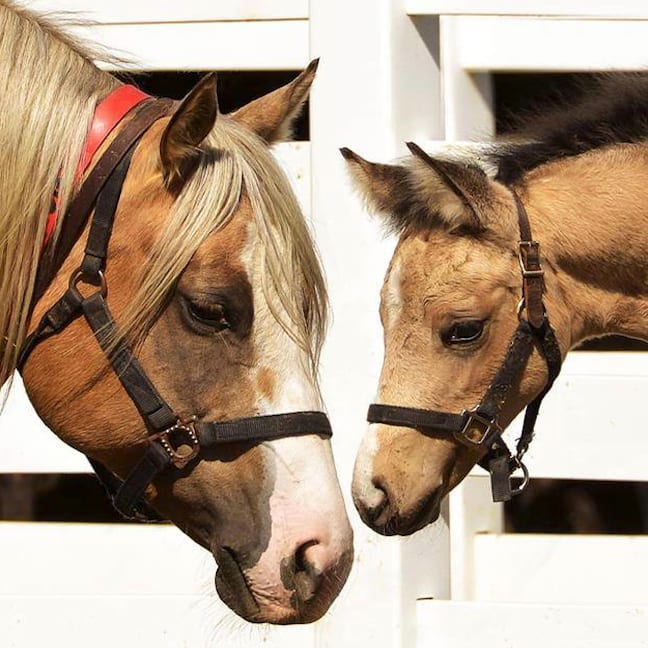Breeders can avoid the heartache of genetic diseases by testing and researching prior to signing a contract.
Breeding Decisions
The wild flowers are blooming, and Facebook newsfeeds are filled with photos of cute newborn foals. It must be spring! Unfortunately, while some mare owners are excitedly sharing photos of their future champions and are working to find that perfect name for their new foals, others will be dealing with the heartbreak of losing a foal and wondering what went wrong.
After paying stud fees and caring for a broodmare, the costs to bring a foal safely into the world can add up. After 11 months of pregnancy and anticipation, some mare owners will meet the harsh reality of having a stillborn foal or one born with a genetic disease that limits not only the foal’s potential, but possibly its life.
Within the bloodlines of American Quarter Horses, five genetic diseases are known and can be detected by genetic testing. Glycogen branching enzyme deficiency (GBED), hereditary equine regional dermal asthenia (HERDA), hyperkalemic periodic paralysis (HYPP), malignant hyperthermia (MH) and polysaccharide storage myopathy (PSSM1).
These genetic defects can effect horses in differing ways from being a carrier with no detrimental health problems to dominant gene expression that results in genetic disorders that can cause death. In addition to the financial losses associated with dealing with medical issues, these diseases can also cause suffering for the effected animals.
While popular pedigrees, show ring success and other factors go into finding the perfect match for a broodmare, mare owners should be digging all the way down to a horse’s DNA to make their final breeding decisions.
Read the Fine Print
Beginning this year, AQHA will require all American Quarter Horse stallions that breed 25 or more mares to have a genetic disease panel test on file before AQHA will register any of their 2014 foals. Next year, all American Quarter Horse stallions regardless of the number of mares bred will be required to have a genetic disease panel test on file with AQHA prior to any of the stallion’s 2015 foals being registered. AQHA will not release stallions’ test results to the public, but stallion owners will know the results and should be willing to share this information with mare owners interested in breeding to a specific stallion.
While most stallion owners will not advertise that their horses are effected by a genetic disorder, mare owners might find information in breeding contracts. For instance, one contract contains the following clause:
“The Mare Owner acknowledges that the Stallion has been tested as a carrier for Glycogen branching enzyme deficiency “GBED” and that the Mare will be required to submit a negative GBED test prior to breeding. The Mare Owner acknowledges that the resulting foal has the potential to have a white hair coat.”
Mare owners should inquire about a stallion’s possible genetic issues before booking their mares, but they should also know about any possible genetic diseases that their mare might pass on as well.
One example of a genetic disorder in the Quarter Horse industry is glycogen branching enzyme deficiency, which was discovered by researchers at the University of Minnesota. The disorder causes muscle weakness and is also responsible for late term abortions or stillbirths. Researchers estimate that at least 3 percent of abortions in Quarter Horses is due to GBED. Foals born alive often are weak and can develop seizures. According the University of Minnesota, all known cases of GBED have been euthanized or died by 18 weeks of age despite aggressive treatment.
The disease is an autosomal (non-sex cell) recessive disease. Testing of breeding horses is important because horses can be carriers and show no signs of the disease. Affected foals receive an abnormal allele from both the dam and the sire. The mutation is located on chromosome 26 and terminates protein synthesis.
If both the mare and stallion are GBED carriers, their foals have a 25 percent chance of being born with the disease and 50 percent chance of being a carrier.
If a normal mare is bred to the above mentioned stallion that is a GBED carrier, there is zero chance of the foal being born with the disease, but there is a 50 percent chance that the foal could be a carrier and possess the recessive gene.
While GBED foals usually show signs and effects of the disease early on, horses that are effected by HERDA and not confirmed through genetic testing are usually not diagnosed until after they begin saddle training and the skin condition is exposed. HERDA foals rarely show signs of the disease at birth.
Like GBED, HERDA is also an autosomal (non-sex cell) recessive disease and the same percentages apply to carriers of the disease.
Hereditary equine regional dermal asthenia has been traced to Poco Bueno but could have started with an ancestor of the stallion. Because of the particular bloodlines, the cutting industry has the most horses affected by the disease, which causes abnormal skin along the back. The skin of HERDA-affected horses is usually loose, or hyper-elastic, and tears easily. The resulting injuries heal into disfiguring scars. With no cure, horses with the disease are not able to be ridden and most are euthanized.
Passing the Test
The American Quarter Horse Association offers genetic testing through the University of California – Davis, but many other labs, including other universities and private businesses, also offer the service. Through AQHA, members can have the five-panel test performed for $85 while nonmembers pay $125. When having a foal or breeding stock DNA tested, the five-panel test can also be ordered. The cost for the DNA testing and five-panel test is $105 for AQHA members and $145 for nonmembers.
The DNA testing is performed on mane or tail hairs. To submit hair for a test, owners should pull 20 to 30 hairs from the horse’s mane or tail and ensure that the hairs contain the actual root. Do not cut hair for testing as the root is what contains the genetic material that will be tested.
The hair samples are sent to the lab along with any forms and payment required. Owners can have results back in as little as two to six business days and be better prepared to make breeding decisions in the best interest of their future foal.
Francis Bacon once said, “Knowledge is power.” Today, horse owners have the power of genetic knowledge on their side when making breeding decisions for their horses. With all the expenses of breeding horses an investment of less than $100 seems like a small price to pay to prevent a genetic tragedy.
About the Author–Jennifer K. Hancock has been obsessed by horses since the time she began walking. She grew up showing American Quarter Horses and worked as a racehorse groom while studying animal science and ag journalism at Texas A&M University. Her career has included stops at Sam Houston Race Park as the media relations coordinator and pressbox manager; the American Quarter Horse Association first as editor of the Racing Journal and later as director of marketing; and the Mustang Heritage Foundation as director of marketing. In 2013, she opened Lone Oak Marketing, where she offers freelance marketing, public relations and writing services, and spends her free time with her menagerie that includes a horse, donkey, goat and a small pack of dogs.








